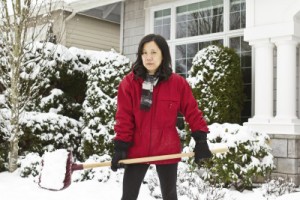Simple Steps to Prevent Back Injuries from Shoveling Snow

By Dr. Andrew Peretz, Somers Orthopaedic Surgery & Sports Medicine
Each year, tens of thousands of people seek medical attention for snow-shoveling injuries – 70,000 in 2008, according to the Consumer Products Safety Commission. A quarter of those individuals visited an emergency room and about 900 were admitted to a hospital. The most commonly injured area of the body was the lower back, representing more than one third of all incidents. Injuries were caused most often by overworking muscles (54 percent), followed by slipping and falling (20 percent), and being struck by the shovel (15 percent).
In the cold weather, our muscles are tight and taut when cold and more easily injured than when warmed up and flexible. The cold also reduces the blood supply to some muscles, making them more prone to cramping or spasms, especially when they are already overworked and tired. It’s not surprising that muscle, ligament, tendon, and other soft tissue injuries top the list of snow-shoveling mishaps, especially to the lower back. And anyone who doesn’t exercise regularly or is in poor physical shape is at increased risk of back injury.
Simple tips to get you through the winter without injury:
- Warm up before you dig in: You’ll do your back a favor if you warm up for five to ten minutes before shoveling. Get your blood moving with a brisk walk, jogging or marching in place, or running up the stairs. Then stretch your lower back and hamstrings (the large muscles in the back of the thigh) with some gentle stretching exercises.
- Use the right shovel: The basic snow shovel hasn’t changed much since it was invented over 100 years ago. Hand grips are often lacking and the shovel length is typically too short for most people, forcing the user to bend and twist while heaving snow. Newer, ergonomic snow shovels take some of the effort out of snow removal. They are typically made of lighter materials such as plastic or lightweight aluminum and feature a curved handle or adjustable handle length to reduce or eliminate bending.
- Use proper shoveling technique: Whenever possible, push the snow aside instead of lifting it. If you must lift, follow these guidelines:
- Bend your knees and lift with your leg muscles – not your back!
- Avoid twisting; pivot your whole body to change direction.
- Do not throw snow over your shoulder.
- Keep each load light.
- If you must lift a full shovel, grip the shovel with one hand as close to the blade as comfortably possible and the other hand on the handle.
- Walk to a new location to deposit the snow; do not reach or toss.
- Clear early and often: It’s easier to clear a light layer than to wait until all the snow has fallen and it’s packed and heavy. In deep snow, remove a few inches off the top at a time rather than attempting to shovel the full depth at once.
- Stay on your feet: Wear shoes or boots with good treads and spread sand, rock salt, or kitty litter on your sidewalk or driveway to increase traction and reduce the likelihood of slipping.
- Take it easy: Take a break every 10-15 minutes; stand up straight, walk around, and drink water to avoid dehydration and overheating. Listen to your body; when it says “stop” STOP.
- Consider a snow blower: When used correctly, a snow blower puts less stress on your lower back than shoveling. Use the power of your legs to push the snow blower while keeping your back straight and knees bent.
There are some people who shouldn’t shovel snow at all. But the good news is that for those whose doctors declare them fit enough to shovel, this winter chore can be good exercise. Even 15 minutes of shoveling counts as moderate physical exercise. And keeping these shoveling guidelines in mind will reduce the chances of developing or aggravating back problems and help get you through the winter injury free.
Dr. Andrew M. Peretz, M.D., a board-certified orthopaedic surgeon specializing in spinal surgery, joined Somers Orthopaedic Surgery in 1997 to treat spinal disorders in both adults and pediatric patients. www.somersortho.com

Adam has worked in the local news industry for the past two decades in Westchester County and the broader Hudson Valley. Read more from Adam’s author bio here.
